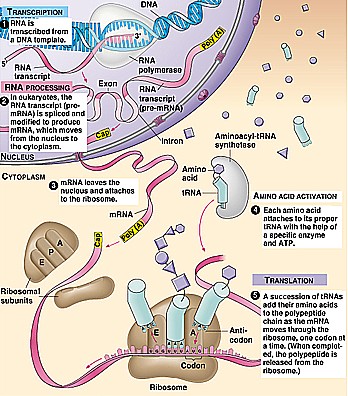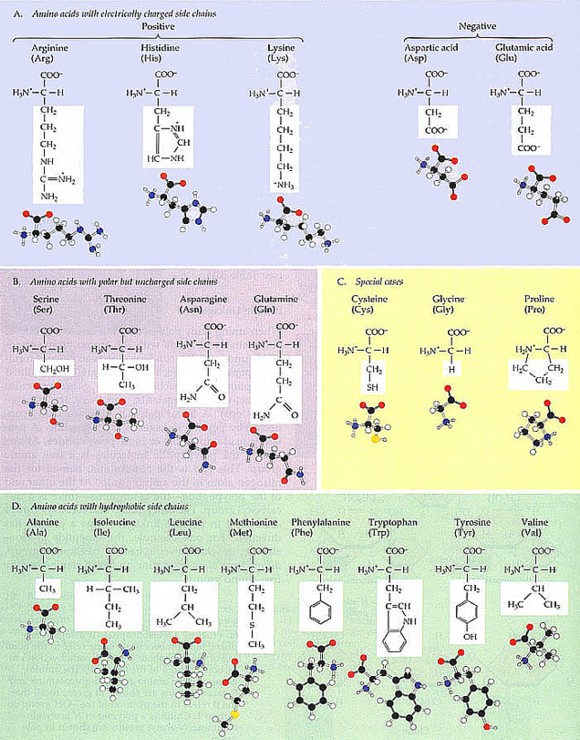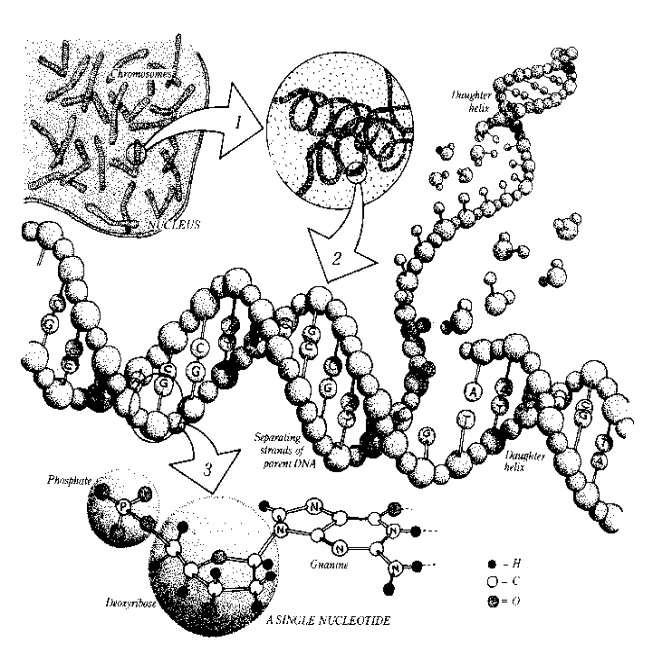 The letters D.N.A. stand for Deoxyribonucleic Acid. DNA is the informational blueprint of all known life forms excluding the questionable life forms of some viruses that use a similar chemical blueprint structure called R.N.A. (Ribonucleic Acid).
The letters D.N.A. stand for Deoxyribonucleic Acid. DNA is the informational blueprint of all known life forms excluding the questionable life forms of some viruses that use a similar chemical blueprint structure called R.N.A. (Ribonucleic Acid)..
.
.
.
.
The Chicken or the Egg,
DNA or Protein?
Sean D. Pitman M.D.
© January 2007
Updated February 2016
.
.
.
.
 The letters D.N.A. stand for Deoxyribonucleic Acid. DNA is the informational blueprint of all known life forms excluding the questionable life forms of some viruses that use a similar chemical blueprint structure called R.N.A. (Ribonucleic Acid).
The letters D.N.A. stand for Deoxyribonucleic Acid. DNA is the informational blueprint of all known life forms excluding the questionable life forms of some viruses that use a similar chemical blueprint structure called R.N.A. (Ribonucleic Acid).
DNA consists of 4 basic sub-units called nucleic acids (Adenine, Thymine, Guanine, and Cytosine). Each nucleic acid has a specific binding pair (A-T and C-G). These come together in the shape of a ladder twisted in a spiral that is commonly called a "Double Helix." Any letter can be next to any other on the poles of the ladder, but an "A" will only connect with a "T" across each "rung" or "step" of the ladder (Likewise a C with a G).
These basic units of DNA, when arranged in specific orders and functional sections along the poles of the ladder, are called genes. Each gene contains a message or "code." These codes are read by specific groups of proteins that decode the message contained in the various DNA sequences of A, T, C, and G. The proteins that read the DNA make a single stranded "working copy" of the DNA called messenger RNA (mRNA). This process is called transcription. After mRNA is made, several other different groups of proteins read the mRNA message.
 These proteins that read the mRNA bring together single protein units called amino acids and attach them together to form a new chain of amino acids that, when folded properly, becomes a new functional protein (after some complicated modifications).
These proteins that read the mRNA bring together single protein units called amino acids and attach them together to form a new chain of amino acids that, when folded properly, becomes a new functional protein (after some complicated modifications).
Practically all living cells of all creatures on this Earth form all their proteins in this manner. Proteins are the functional units of the cell. They make the cell able to work. Most functions of the cell depend on proteins to perform them - to including the creation of proteins to begin with. In fact, as has been very briefly detailed, proteins make themselves by decoding the information contained in DNA that tells the builder proteins how to make themselves. Every single step requires energy in the form of a molecule called Adenosine Tri-phosphate (A.T.P.). Not just any energy form will do. The cell can only use ATP to perform useful functions. It is very picky. And, interestingly enough, ATP is also created with the help of very specific proteins.
Question?
In the very first cell (assuming that there was a "first" cell) what came first - the DNA or the protein? Of course, the protein that reads the DNA is itself coded for by the DNA. So, the protein could not be there first since its code or order is contained in the DNA that it decodes. Proteins would have to decode themselves before they could exist. So obviously, without the protein there first, the DNA would never be read and the protein would never be made. Likewise, the DNA could not have been there first since DNA is made and maintained by the proteins of the cell. Some popular theories about abiogenesis suggest that RNA probably evolved first and then DNA. But this doesn't remove the problem. RNA still has to be decoded by very specific proteins that are themselves coded for by the information contained in the RNA. Obviously both DNA and/or RNA and the fully formed decoding protein system would have to be present at the same time in order for the system as a whole to work. There simply is no stepwise function-based selection process since natural selection isn't even capable of working at this point in time. Stephen Meyer does a good job at explaining the details as to why in his book, Signature in the Cell and in his critique of the work of Manchester chemist John Sutherland and his description of an "RNA World" (Link).
"In Chapter 14 of my book I describe and critique the RNA world scenario. There I describe five major problems associated with the theory. Sutherland’s work only partially addresses the first and least severe of these difficulties: the problem of generating the constituent building blocks or monomers in plausible pre-biotic conditions. It does not address the more severe problem of explaining how the bases in nucleic acids (either DNA or RNA) acquired their specific information-rich arrangements. In other words, Sutherland’s experiment helps explain the origin of the “letters” in the genetic text, but not their specific arrangement into functional “words” or “sentences.”
Even so, Sutherland’s work lacks pre-biotic plausibility and does so in three ways that actually underscore my argument.
First, Sutherland chose to begin his reaction with only the right-handed isomer of the 3-carbon sugars he needed to initiate his reaction sequence. Why? Because he knew that otherwise the likely result would have had little biologically-significance. Had Sutherland chosen to use a far more plausible racemic mixture of both right and left-handed sugar isomers, his reaction would have generated undesirable mixtures of stereoisomers—mixtures that would seriously complicate any subsequent biologically-relevant polymerization. Thus, he himself solved the so-called chirality problem in origin-of-life chemistry by intelligently selecting a single enantiomer, i.e., only the right-handed sugars that life itself requires. Yet there is no demonstrated source for such non-racemic mixture of sugars in any plausible pre-biotic environment.
Second, the reaction that Sutherland used to produce ribonucleotides involved numerous separate chemical steps. At each intermediate stage in his multi-step reaction sequence, Sutherland himself intervened to purify the chemical by-products of the previous step by removing undesirable side products. In so doing, he prevented—by his own will, intellect and experimental technique—the occurrence of interfering cross-reactions, the scourge of the pre-biotic chemist.
Third, in order to produce the desired chemical product—ribonucleotides—Sutherland followed a very precise “recipe” or procedure in which he carefully selected the reagents and choreographed the order in which they were introduced into the reaction series, just as he also selected which side products to be removed and when. Such recipes, and the actions of chemists who follow them, represent what the late Hungarian physical chemist Michael Polanyi called “profoundly informative intervention[s].” Information is being added to the chemical system as the result of the deliberative actions—the intelligent design—of the chemist himself.
In sum, not only did Sutherland’s experiment not address the more fundamental problem of getting the nucleotide bases to arrange themselves into functionally-specified sequences, the extent to which it did succeed in producing more life-friendly chemical constituents actually illustrates the indispensable role of intelligence in generating such chemistry.
The second experiment that Falk cites to refute my book illustrates this problem even more acutely. This experiment is reported in a scientific paper by Tracey Lincoln and Gerald Joyce ostensibly establishing the capacity of RNA to self-replicate, thereby rendering plausible one of the key steps in the RNA world hypothesis. Falk incorrectly intimates that I did not discuss this experiment in my book. In fact, I do on page 537.
In any case, it is Falk who draws exactly the wrong conclusion from this paper. The central problem facing origin-of-life researchers is neither the synthesis of pre-biotic building blocks (which Sutherland’s work addresses) or even the synthesis of a self-replicating RNA molecule (the plausibility of which Joyce and Tracey’s work seeks to establish, albeit unsuccessfully: see below). Instead, the fundamental problem is getting the chemical building blocks to arrange themselves into the large information-bearing molecules (whether DNA or RNA). As I show in Signature in the Cell, even the extremely limited capacity for RNA self-replication that has been demonstrated depends critically on the specificity of the arrangement of nucleotide bases—that is, upon pre-existing sequence-specific information.
The Lincoln and Joyce experiment that Falk describes approvingly does not solve this problem, at least not apart from the intelligence of Lincoln and Joyce. In the first place, the “self-replicating” RNA molecules that they construct are not capable of copying a template of genetic information from free-standing chemical subunits as the polymerase machinery does in actual cells. Instead, in Lincoln and Joyce’s experiment, a pre-synthesized specifically sequenced RNA molecule merely catalyzes the formation of a single chemical bond, thus fusing two other pre-synthesized partial RNA chains. In other words, their version of ‘self-replication’ amounts to nothing more than joining two sequence specific pre-made halves together. More significantly, Lincoln and Joyce themselves intelligently arranged the matching base sequences in these RNA chains. They did the work of replication. They generated the functionally-specific information that made even this limited form of replication possible.
The Lincoln and Joyce experiment actually confirms three related claims that I make in Signature in the Cell. First, it demonstrates that even the capacity for modest partial self-replication in RNA itself depends upon sequence specific (i.e., information-rich) base sequences in these molecules. Second, it shows that even the capacity for partial replication of genetic information in RNA molecules results from the activity of chemists, that is, from the intelligence of the “ribozyme engineers” who design and select the features of these (partial) RNA replicators. Third, pre-biotic simulation experiments themselves confirm what we know from ordinary experience, namely, that intelligent design is the only known means by which functionally specified information arises."
Just like the chicken and the egg paradox, it seems like the function of the most simple living cell is dependent upon all its parts being there in the proper order simultaneously. Some have referred to such systems as "irreducibly complex" in that if any one part is removed, the higher "emergent" function of the collective system vanishes. This apparent irreducibility of the living cell is found in the fact that DNA makes the proteins that make the DNA. Without either one of them, the other cannot be made or maintained. Since these molecules are the very basics of all life, it seems rather difficult to imagine a more primitive life form to evolve from. No one has been able to adequately propose what such a life form would have looked like or how it would have functioned. Certainly no such life form or pre-life form has been discovered. Even viruses and the like are dependent upon the existence of pre-established living cells to carry out their replication. They simply do not replicate by themselves. How then could the first cell have evolved from the non-living soup of the "primitive" prebiotic oceans?
This really is quite a problem to try and explain. After all, what selective advantage would be gained for non-thinking atoms and molecules to form a living thing? They really gain nothing from this process so why would a mindless non-directed Nature select to bring life into existence? Natural selection really isn't a valid force at this point in time since there really is no conceivable advantage for mindless molecules to interact as parts of a living thing verses parts of an amorphous rock or a collection of sludge. Even if a lot of fully formed proteins and strings of fully formed DNA molecules were to come together at the same time, what are the odds that all the hundreds and thousands of uniquely specified proteins needed to decode both the DNA and mRNA, (not to mention the needed ATP molecules and the host of other unlisted "parts"), would all simultaneously fuse together in such a highly functional way? Not only has this phenomenon never been reproduced by any scientist in any laboratory on earth, but a reasonable mechanism by which such a phenomenon might even occur has never been proposed - outside of intelligent design that is.
 This is just one little problem that must be overcome to explain the existence of the very first living cell. According to the theory of evolution, the first living cell had to have been formed by mindless naturalistic mechanisms that defy all the known laws of nature. Natural law says that all inanimate matter desires equilibrium. Homogeny is the ultimate goal of nature, even with the input of large amounts of outside heat or disordered energy from the Sun (just try heating up a collection of organic matter and see what happens - all that will happen is that it will become hot homogenous ooze, but nothing much more complex than this).
This is just one little problem that must be overcome to explain the existence of the very first living cell. According to the theory of evolution, the first living cell had to have been formed by mindless naturalistic mechanisms that defy all the known laws of nature. Natural law says that all inanimate matter desires equilibrium. Homogeny is the ultimate goal of nature, even with the input of large amounts of outside heat or disordered energy from the Sun (just try heating up a collection of organic matter and see what happens - all that will happen is that it will become hot homogenous ooze, but nothing much more complex than this).
The most simple living cell is almost infinitely far away from chaotic homogeny. Every living cell is at an extremely high level of meaningful informational complexity and yet just one of these amazing machines, which still cannot be reproduced by science, just happened to come together even before "natural selection" was even theoretically around?!
All the building blocks for a supercomputer are there mixed up in the desert sands. Volcanic activity, lightening, and wind could provide the necessary energy for construction. What's the problem then? Homogeny. Homogeny is the problem. Parts do not assemble themselves in a non-homogenous way that is very far beyond the sum of the collectively functional/meaningful information contained in the individual parts themselves. This just doesn't happen via the normal mindless processes of nature. Pre-established information and directed energy from an outside source is needed for the assembly of parts that produce a function that is very much greater than the informational sum of the individual parts. It is the pre-established order of a living cell, to include the pre-formed information contained in its DNA that allows it to be what it is. If brought together randomly, the individual parts of a cell would never self-assemble themselves into the form and function of a living cell regardless of how much outside energy and interactive potential was provided to the parts.
It would be like taking millions of watch parts and shaking them all together for a billion years and expecting a watch to self-assemble just because all the necessary parts and required energy are there. After a billion years, or even trillions upon trillions of years, would anyone really expect something even close to the functional level of a watch to be formed by such a process? How then are the molecules that form a living cell any different?
BioVisions at Harvard University
Cellular Visions: The Inner Life of a Cell
Dean Kenyon, Author of Biochemical Predestination: (Link)
Dean Kenyon was a leading evolutionary biologist from the 1960s through the 1980s, but eventually became a reluctant believer in Intelligent Design after being challenged by one of his students to explain protein assembly without original sequence information
The Atmosphere Problem (Link)
. Home Page . Truth, the Scientific Method, and Evolution
.
Methinks it is Like a Weasel .The Cat and the Hat - The Evolution of Code . Maquiziliducks - The Language of Evolution . Defining Evolution
.
The God of the Gaps . Rube Goldberg Machines. Evolving the Irreducible .
Gregor Mendel .
Natural Selection .Computer Evolution .
The Chicken or the Egg .Antibiotic Resistance .
The Immune System .Pseudogenes .
Genetic Phylogeny .Fossils and DNA . DNA Mutation Rates . Donkeys, Horses, Mules and Evolution
.
The Fossil Record . The Geologic Column .
Carbon 14 and Tree Ring Dating .Radiometric Dating . Amino Acid Racemization Dating . The Steppingstone Problem
.
Quotes from Scientists .Ancient Ice .
Meaningful Information . The Flagellum. Harlen Bretz . Milankovitch Cycles
. Kenneth Miller's Best Arguments
Since June 1, 2002